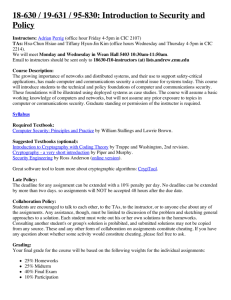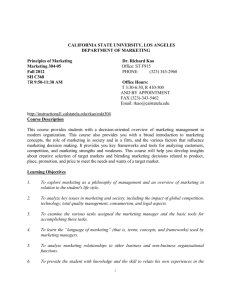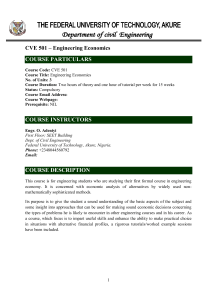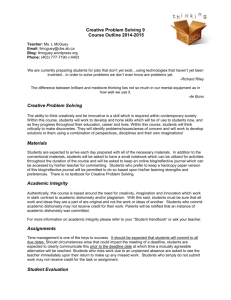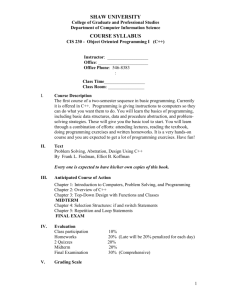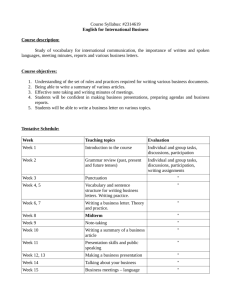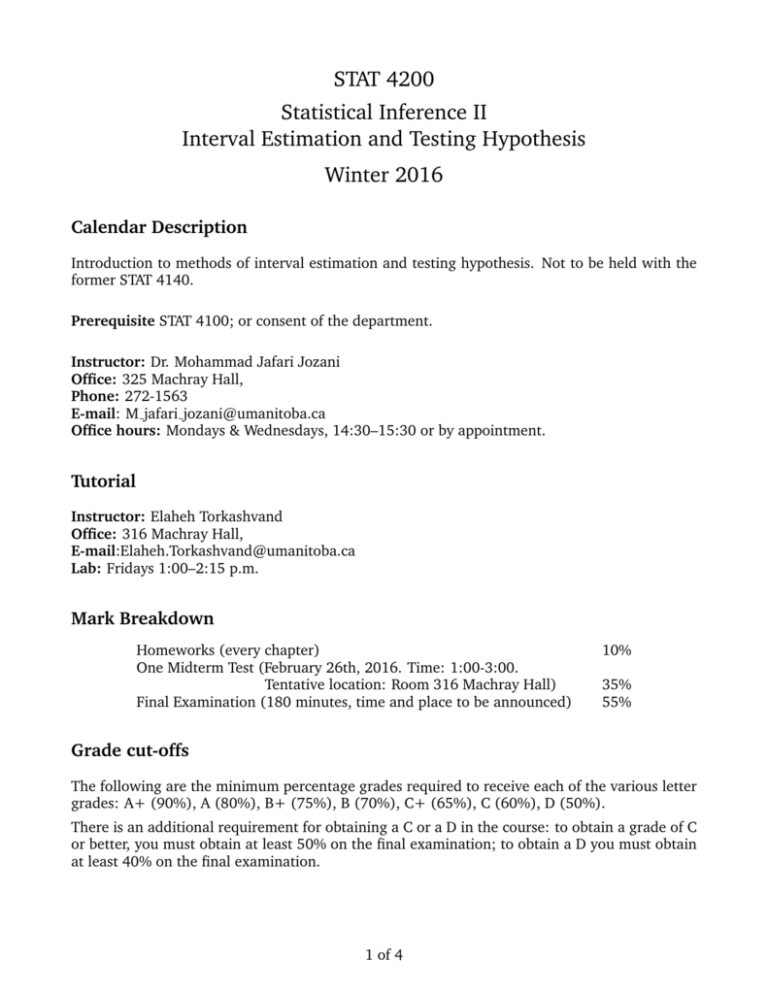
STAT 4200
Statistical Inference II
Interval Estimation and Testing Hypothesis
Winter 2016
Calendar Description
Introduction to methods of interval estimation and testing hypothesis. Not to be held with the
former STAT 4140.
Prerequisite STAT 4100; or consent of the department.
Instructor: Dr. Mohammad Jafari Jozani
Office: 325 Machray Hall,
Phone: 272-1563
E-mail: M jafari jozani@umanitoba.ca
Office hours: Mondays & Wednesdays, 14:30–15:30 or by appointment.
Tutorial
Instructor: Elaheh Torkashvand
Office: 316 Machray Hall,
E-mail:Elaheh.Torkashvand@umanitoba.ca
Lab: Fridays 1:00–2:15 p.m.
Mark Breakdown
Homeworks (every chapter)
One Midterm Test (February 26th, 2016. Time: 1:00-3:00.
Tentative location: Room 316 Machray Hall)
Final Examination (180 minutes, time and place to be announced)
10%
35%
55%
Grade cut-offs
The following are the minimum percentage grades required to receive each of the various letter
grades: A+ (90%), A (80%), B+ (75%), B (70%), C+ (65%), C (60%), D (50%).
There is an additional requirement for obtaining a C or a D in the course: to obtain a grade of C
or better, you must obtain at least 50% on the final examination; to obtain a D you must obtain
at least 40% on the final examination.
1 of 4
Homeworks
Homeworks and Assignments are due at the start of class (time will be announced). Homeworks
submitted late will be severely penalized. Homeworks submitted after the solutions are posted
or after the graded assignments are return to students will not be marked and receive a grade
of 0. Obviously, exceptions can be made to the above policy if special/exceptional circumstances
warrant them (e.g., serious illness).
Students are encouraged to discuss and work together on the solutions to the assignments.
However, each student must hand in his or her own copy of each assignment with personalized
solutions, including comments, discussions and interpretations. Note that actions will be taken
against students who are found guilty of acts of academic dishonesty.
Your assignments should conform to the following standards:
• Assignments are to be done on 8.5 × 11 paper, writing on one side only.
• Assignments are to be stapled.
• Write your name at the top of each page.
• Assignments that involve R programming should be accompanied with the R codes.
• Revise your assignments so they are reasonably free of grammatical and typographical
errors.
• Make sure each step in your solutions is well justified: I mark what is written on paper and
should not have to guess what you mean.
• Messy or unreadable assignments will be returned with a mark of zero.
• Assignments that are well presented and properly typesetted in Latex will get up to a 5%
bonus.
Tests
The midterm test and the final examination are closed book. Statistical tables will be provided if
required. A non-programmable calculator might be necessary (graphing calculators are not permitted). However, other electronic devices, such as cell phones and MP3, are strictly prohibited.
If you miss the midterm test, you will be assigned a mark of zero, unless reasons and acceptable
evidence are provided. A make-up test will not be scheduled. Students who miss the midterm
test with legitimate reasons will have the midterm weight added to the final examination. The
Final Exam will be held on a date to be selected later by the Department of Statistics and will be
3 hours in duration.
2 of 4
Recommended Text Books
I will use my course own notes. However, I recommend to use the following textbooks for further
reading and exercises.
(1) Mathematical Statistics (Second Edition)
by: Jun Shao
Springer Texts in Statistics
ISBN 0-387-95382-5
2003.
(2) Probability and Statistical Inference
by: Nitis Mukhopadhyay
Marcel Dekker
ISBN 0-8247-0319-0
2000.
(3) Statistical Inference (Second Edition)
by G. Casella and R.L. Berger
Duxbury/Thomson Learning
ISBN 0-534-24312-6
2002.
(4) Introduction to Mathematical Inference (Sixth Edition)
by R.V. Hogg, J.W. McKean and A.T. Craig
Pearson/Prentice Hall
ISBN 0-13-008507-3
2005.
Voluntary Withdrawal
Note that the voluntary withdrawal date is April 18, 2016.
Academic Dishonesty
It is important that you understand what constitutes academic dishonesty and that you are familiar with the very serious consequences. Links to resources that that describe academic dishonesty
(including plagiarism, cheating, inappropriate collaboration and examination impersonation)
can be found at:
http://www.umanitoba.ca/faculties/science/student/webdisciplinedocuments.html
or through the Faculty of Science home page at:
http://umanitoba.ca/faculties/science.
Typical penalties imposed within the Faculty of Science for academic dishonesty are also described. See also:
http://crscalprod1.cc.umanitoba.ca/Catalog/ViewCatalog.aspx?pageid=viewcatalog
&catalogid=60&chapterid=227&topicgroupid=4056&loaduseredits=False.
3 of 4
2015-2016 REGISTRATION ADVISORY
Important Note from the Dean of Science:
It is your responsibility to ensure that you are entitled to be registered in this course. This means
that you have:
• the appropriate prerequisites, as noted in the calendar description, or have permission
from the instructor to waive these prerequisites;
• not previously taken, or are concurrently registered in, this course and another that has
been identified as not to be held with in the course description. For example, STAT 1000
cannot be held for credit with STAT 2220.
The registration system may have allowed you to register in this course, but it is your responsibility to check. If you are not entitled to be in this course, you will be withdrawn, or the course
may not be used in your degree program. There will be no fee adjustment. This is not appealable. Please be sure to read the course description for this and every course in which you are
registered.
Tentative Topics
Interval Estimation: Methods of finding interval estimators (Pivotal quantities, Pivoting the
CDF, General Methods); Equal-tail, shortest-tail and unbiased confidence intervals; Large
sample and asymptotic interval estimation; Confidence intervals for the quantiles of the
(finite and infinite) population using large and small sample sizes.
Testing Hypothesis: Most powerful tests; Likelihood ratio tests (LRT); Uniformly most powerful tests; Monotone likelihood ratio property; Asymptotic distribution of LRT. Sequential
Tests and Bayesian Tests (if time permits).
Bootstrap and Resampling methods for interval estimation and testing hypothesis.
4 of 4

